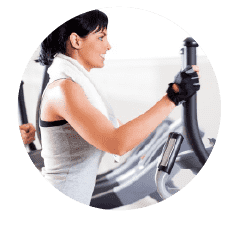Pre Elliptical-Workout Warm-Up Tips
Everyone can agree that stretching feels great on the body. But did you know that stretching before a workout is actually frowned upon? Why, you ask? It’s simple. When working out, muscles need to contract as strongly as possible, and when you stretch, you’re placing your muscles in a stretched state, and hindering the muscles’ ability to contract quickly and powerfully. According to the New York Times, if you stretch before you lift weights, you may find yourself feeling weaker and wobblier than you’d expect during your workout. A better choice? Scientists recommend a dynamic warm-up that consists of moving the muscles that will be called upon in your workout. Muscleandfitness.com explains, “think of the warm-up like getting your car aligned – the right blend of drills will improve your posture, set your muscles and joints in the right position, and keep you safe.” Warming up the right way will make your workout feel easier than if you were just hopping off the couch and going for it. A proper warm-up increases muscle temperature, endurance and speed, helping you run faster and jump higher. It also increases your range of motion, and warms you up mentally, increasing motivation and focus (experiencelife.com). If you’re thinking about hitting the elliptical, warming up is key. Elliptical machines work the lower body since you’re pedaling in an elliptical pattern, and because of this, calf muscles are targeted since you’re using forward and reverse motions.
Read on for the best pre-elliptical stretches:
Wall Stretches
One of our favorite ways to stretch the calves, this move is easy to do anywhere, anytime. Simply find a wall, stand in front of it, and place yourself about arm’s length away with your left foot behind your right in a lunge pose. Keep your left leg straight, push your heel into the floor, and bend your right knee. Stand up straight when you feel a stretch in the back of your calves, and stay in the stretch for approximately 30 seconds. Switch, and complete the move on the other side.
Step Stretch
This move targets both the calves and the shins. Simply place your foot on a step, with your right foot to the rear with only the ball of the foot in contact with the platform. Bend the left knee and push your right heel towards the ground. Hold for 30 seconds, and complete the move on the other side.
Butt Kicks
Butt kicks are one of the best ways to warm up the muscles in your legs and increase your core body temperature. Bonus: they also improve your running stride and posture (see more tips on how ellipticals can improve your running). Simply bend your knee and kick your lower leg behind you, touching your heel to your glutes – easy and elliptical approved!
Trunk Rotations
Trunk Rotations improve strength and flexibility in the legs, shoulders, and core, all while increasing body temperature and blood flow. Lie on your back with your hips and knees bent, so that your feet are flat on the floor, and your arms are comfortably at your sides. Squeeze your shoulder blades and flatten your neck to the floor while you rotate your legs to the left. Continue to twist your body, and be sure to keep your right shoulder blade and forearm flat on the floor. Hold for 3-5 minutes, and slowly return to the starting position. Repeat on the right side.
Pike Stretch
This move targets the hamstrings and calves. Stand with your legs shoulder width apart, and reach down and touch your hands in front of your toes. Walk your hands forward while keeping them shoulder-width apart, and be sure to keep the knees straight as your body forms an inverted “V.” This is very similar to the yoga stretch, the “downward dog”. Keep the feet on the floor and stay in the stretch for 30 seconds.
If using the elliptical for your main workout just isn’t your thing, try it as a warm-up instead. It’s a great way to increase your body temperature and it also lubricates your joints – just make sure the machine is on the easiest setting, and build your pace for around 10 minutes. Once your body feels warm, you’re good to go!
One last note: When choosing your warm-up activity, opt for something that uses the same muscles you’ll be working during your workout. Keep in mind that the best kind of warm-up is an individual process that can only come with practice and experience. Tip: try warming up the body in various ways at various intensities to find what works best for you and your body. And remember, a good warm-up should cause little to mild sweating, but should never leave you feeling fatigued or too tired to workout…that’s why it’s called a warm-up, after all.



 Compact/Folding
Compact/Folding Front Drive
Front Drive Rear Drive
Rear Drive